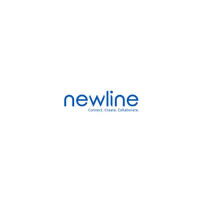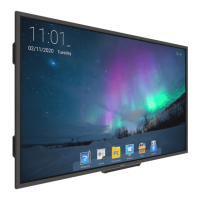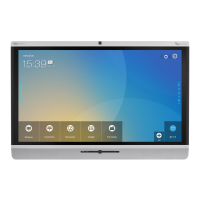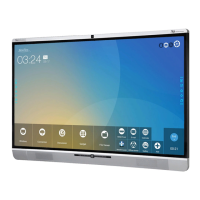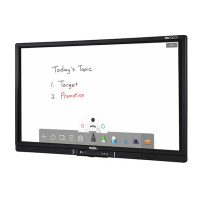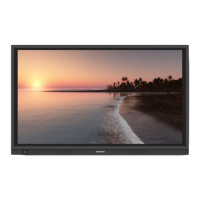Do you have a question about the NewLine TRUTOUCH and is the answer not in the manual?
Key safety warnings regarding power, handling, environment, and remote control usage.
Important cautions regarding high temperatures, transport, radio interference, and optimal usage environment.
Guidance on choosing appropriate mounting methods and ensuring secure installation.
Details ventilation requirements and distances to surfaces for proper air circulation.
Highlights key features of the TRUTOUCH interactive display for education and corporate use.
Illustrations of the front and back views, labeling all external components and ports.
Details the functions of each button on the control panel for device operation.
Diagram and description of ports available on Connection Panel 1.
Diagram and description of ports available on Connection Panel 2.
Diagram and description of ports available on Connection Panel 3.
Explains the function of each button on the remote control for device operation.
Details the effective range and angle for remote control use, along with important safety warnings.
Step-by-step guide to connecting the power cord and turning on the interactive display.
Instructions for safely shutting down the interactive display and its components.
Specifies the minimum hardware requirements for software installation.
Guide on how to remove the IdeaMax software from the computer.
Situations requiring recalibration of the touch display for optimal performance.
Detailed steps for performing a nine-point touch calibration using the software.
Steps to connect the display to the PC and access calibration settings in Windows.
Instructions for executing touch calibration within Windows 10 settings.
Procedure for installing the OPS module into the interactive display.
Overview of the toolbar's three modes (Home, Task Manager, Whiteboard) and its icons.
How to view, switch between, and close applications using the task manager.
Using the whiteboard features for writing, erasing, printing, saving, and clearing content.
How to select pen, adjust weight/color, use the eraser, and cancel operations.
Methods for taking screenshots of the whiteboard content and saving them.
Using the print, clear, and freeze screen functions for whiteboard content.
Accessing the gallery to view images individually or as a slideshow.
Navigating and managing files and folders on the system and external devices.
Description of available system settings such as Network, Apps, and Language.
How to open and navigate websites using the built-in browser.
Activating audio-only mode to turn off the screen while keeping audio active.
Methods to activate and deactivate the child lock feature for security.
Procedure to disable Android USB ports and the method to re-enable them.
Information on real-time temperature display and automatic thermal shutdown functionality.
How to enable remote boot and the requirements for its successful operation.
Steps to access the Design Menu and retrieve the display's MAC address.
How to navigate to and view all available applications on the system.
Instructions for using the calculator and the music player applications.
Methods for choosing the input signal source for the display.
How to access and navigate through the display's menu options.
Adjusting volume, pitch, balance, and selecting sound modes like Standard or Theater.
Options for adjusting screen settings like Auto, P2P, aspect ratio (16:9, 4:3).
Adjusting display settings like brightness, contrast, hue, and sharpness.
Explanation of ECO mode, Auto brightness adjustment, and Standard mode.
Table detailing resolutions, refresh rates, and sync polarity for VGA inputs.
Lists supported file formats and extensions for image, movie, music, and text media.
Provides information on accessing RS-232 control codes via the technical support site.
Guide to diagnosing and resolving common faults like application loading or calibration problems.
Solutions for issues related to no sound, no image, or interrupted audio/video.
Troubleshooting for remote control unresponsiveness and PC startup problems.
General tips for maintaining the product, including cleaning and avoiding damage.
Instructions for cleaning the infrared sensors to ensure accurate touch detection.
Detailed technical specifications of the display, including resolution, brightness, and contrast.
Details on input/output ports, supported multimedia formats, and HDMI HDCP.
Key safety warnings regarding power, handling, environment, and remote control usage.
Important cautions regarding high temperatures, transport, radio interference, and optimal usage environment.
Guidance on choosing appropriate mounting methods and ensuring secure installation.
Details ventilation requirements and distances to surfaces for proper air circulation.
Highlights key features of the TRUTOUCH interactive display for education and corporate use.
Illustrations of the front and back views, labeling all external components and ports.
Details the functions of each button on the control panel for device operation.
Diagram and description of ports available on Connection Panel 1.
Diagram and description of ports available on Connection Panel 2.
Diagram and description of ports available on Connection Panel 3.
Explains the function of each button on the remote control for device operation.
Details the effective range and angle for remote control use, along with important safety warnings.
Step-by-step guide to connecting the power cord and turning on the interactive display.
Instructions for safely shutting down the interactive display and its components.
Specifies the minimum hardware requirements for software installation.
Guide on how to remove the IdeaMax software from the computer.
Situations requiring recalibration of the touch display for optimal performance.
Detailed steps for performing a nine-point touch calibration using the software.
Steps to connect the display to the PC and access calibration settings in Windows.
Instructions for executing touch calibration within Windows 10 settings.
Procedure for installing the OPS module into the interactive display.
Overview of the toolbar's three modes (Home, Task Manager, Whiteboard) and its icons.
How to view, switch between, and close applications using the task manager.
Using the whiteboard features for writing, erasing, printing, saving, and clearing content.
How to select pen, adjust weight/color, use the eraser, and cancel operations.
Methods for taking screenshots of the whiteboard content and saving them.
Using the print, clear, and freeze screen functions for whiteboard content.
Accessing the gallery to view images individually or as a slideshow.
Navigating and managing files and folders on the system and external devices.
Description of available system settings such as Network, Apps, and Language.
How to open and navigate websites using the built-in browser.
Activating audio-only mode to turn off the screen while keeping audio active.
Methods to activate and deactivate the child lock feature for security.
Procedure to disable Android USB ports and the method to re-enable them.
Information on real-time temperature display and automatic thermal shutdown functionality.
How to enable remote boot and the requirements for its successful operation.
Steps to access the Design Menu and retrieve the display's MAC address.
How to navigate to and view all available applications on the system.
Instructions for using the calculator and the music player applications.
Methods for choosing the input signal source for the display.
How to access and navigate through the display's menu options.
Adjusting volume, pitch, balance, and selecting sound modes like Standard or Theater.
Options for adjusting screen settings like Auto, P2P, aspect ratio (16:9, 4:3).
Adjusting display settings like brightness, contrast, hue, and sharpness.
Explanation of ECO mode, Auto brightness adjustment, and Standard mode.
Table detailing resolutions, refresh rates, and sync polarity for VGA inputs.
Lists supported file formats and extensions for image, movie, music, and text media.
Provides information on accessing RS-232 control codes via the technical support site.
Guide to diagnosing and resolving common faults like application loading or calibration problems.
Solutions for issues related to no sound, no image, or interrupted audio/video.
Troubleshooting for remote control unresponsiveness and PC startup problems.
General tips for maintaining the product, including cleaning and avoiding damage.
Instructions for cleaning the infrared sensors to ensure accurate touch detection.
Detailed technical specifications of the display, including resolution, brightness, and contrast.
Details on input/output ports, supported multimedia formats, and HDMI HDCP.
| Category | Interactive Display |
|---|---|
| Resolution | 3840 x 2160 (4K UHD) |
| Response Time | 8 ms |
| Connectivity | Wi-Fi, Bluetooth |
| Speakers | 2 x 15W |
| Touch Technology | Infrared |
| Brightness | 350 cd/m² |
| Viewing Angle | 178° |
| Operating System | Android |
| Processor | Quad-core |
| Ports | HDMI, USB, VGA, Audio Out |
| Screen Size | 65 inches |
| Touch Points | 20-point multi-touch |
